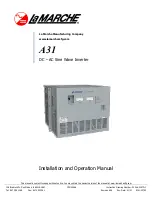
TECHNICAL INFORMATION
Page
106
Copyright
Trace Engineering Company, Inc.
5916 - 195th Street N. E.
Arlington, WA 98223
Telephone: 360/435-8826
Fax: 360/435-2229
www.traceengineering.com
SW Series Inverter/Charger
Part No. 2031-5
Rev. B: Sept 1, 1999
BATTERY INSTALLATION
CAUTION: Batteries can produce extremely high currents if they are short-circuited. Be very
careful when working around them. Read the important safety instructions at the start of this
manual and the battery supplier’s precautions before installing the inverter and batteries.
LOCATION
Batteries should be located in an accessible location with nothing restricting the access to the battery caps
and terminals on the tops. At least 2 feet of clearance above is recommended. They must be located as
close as possible to the inverter, but can not limit the access to the inverter and the inverter’s DC
disconnect. With the SW Series inverter, the batteries are best located to the right side. This is where the
DC connections are located.
Battery to inverter cabling should be only as long as required. For 12 VDC systems, do not exceed 5 feet
(one way) if 4/0 AWG cables are used. For 24 VDC systems, do not exceed 10 feet (one way) if 4/0 AWG
cables are used. For 48 VDC cables, do not exceed 10 feet (one way) if 2/0 AWG cables are used, or 20
feet (one way) if 4/0 AWG cables are used.
BATTERY ENCLOSURES
The batteries must be protected inside of a ventilated, lockable enclosure or room to prevent access by
untrained personnel. The enclosure should be ventilated to the outdoors from the highest point to prevent
accumulation of hydrogen gasses released in the battery charging process. An air intake should also be
provided at a low point in the enclosure to allow air to enter the enclosure to promote good ventilation. For
most systems, a 1-inch diameter vent pipe from the top of the enclosure is adequate to prevent
accumulation of hydrogen. A sloped top can help direct the hydrogen to the vent location and prevent
pockets of hydrogen from occurring. The enclosure should also be capable of holding at least one battery
cell’s worth of electrolyte in case a spill or leak occurs. It should be made of acid resistant material or have
an acid resistant finish applied to resist the corrosion from spilled electrolyte and fumes released. If the
batteries are located outside, the enclosure should be rainproof and include mesh screens over any
openings to prevent insects and rodents from entering. Before putting the batteries in, cover the bottom of
the enclosure with a layer of baking soda to neutralize any acid that might be spilled in the future.
BATTERY TEMPERATURE
The effective capacity of a battery is reduced when cold. This phenomenon is more significant with lead
acid type batteries compared to alkaline types. When the internal temperature of a lead acid battery is
32
°
F (0
°
C) the capacity can be reduced by as much as 50%. This effectively reduces the size of the
system’s “gas tank”, requiring more frequent “refueling” by the back up source (usually a generator). This
should be considered when designing the system. If extremely cold temperatures are expected at the
location of a system, either a heated equipment room or alkaline batteries should be considered.
If the system is located in an unheated space, an insulated enclosure is highly recommended for the
batteries. During the charging process, the batteries release heat due to the internal resistance of the
battery. If the batteries are insulated, the heat can be kept in the batteries to keep them warmer. This will
substantially increase the performance of the system.
Insulated battery enclosures also ensure that the temperatures of the individual battery cells are more
consistent, preventing unequal charging which can cause battery failure (some cells will be overcharged
while others are undercharged).
The batteries should also be protected from high temperature as well. This can be caused by high
ambient temperatures, solar heating of the battery enclosure, or heat released by a closely located
generator. High battery temperatures will result in short battery life and should be avoided by ventilating
the enclosure and reducing the external heat sources by shading and insulation.
Summary of Contents for SW II - REV 4.01
Page 151: ......
















































